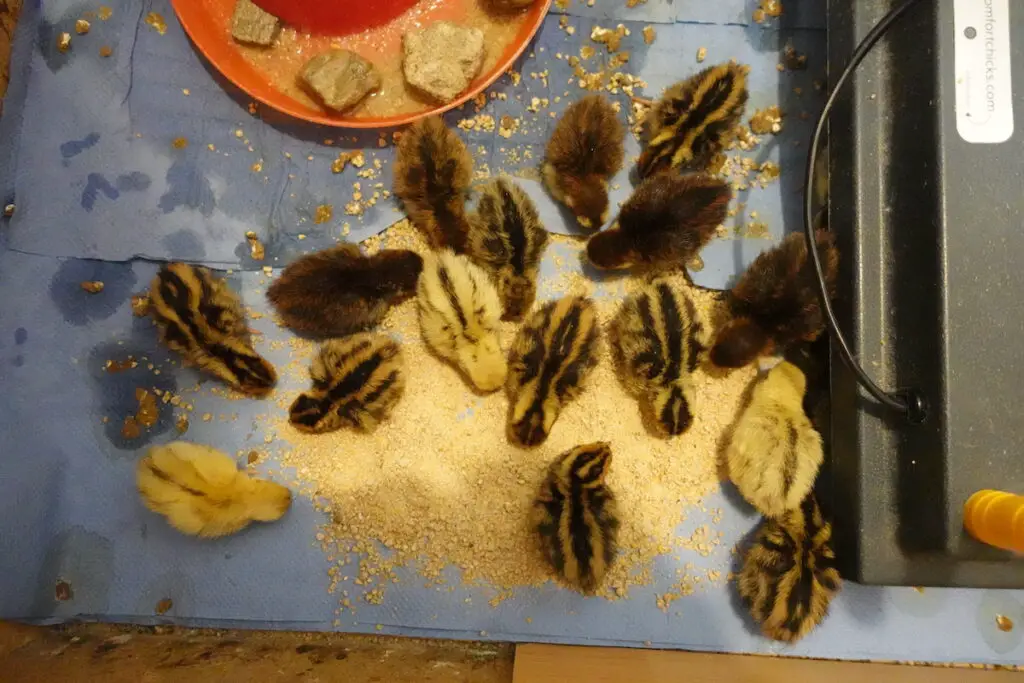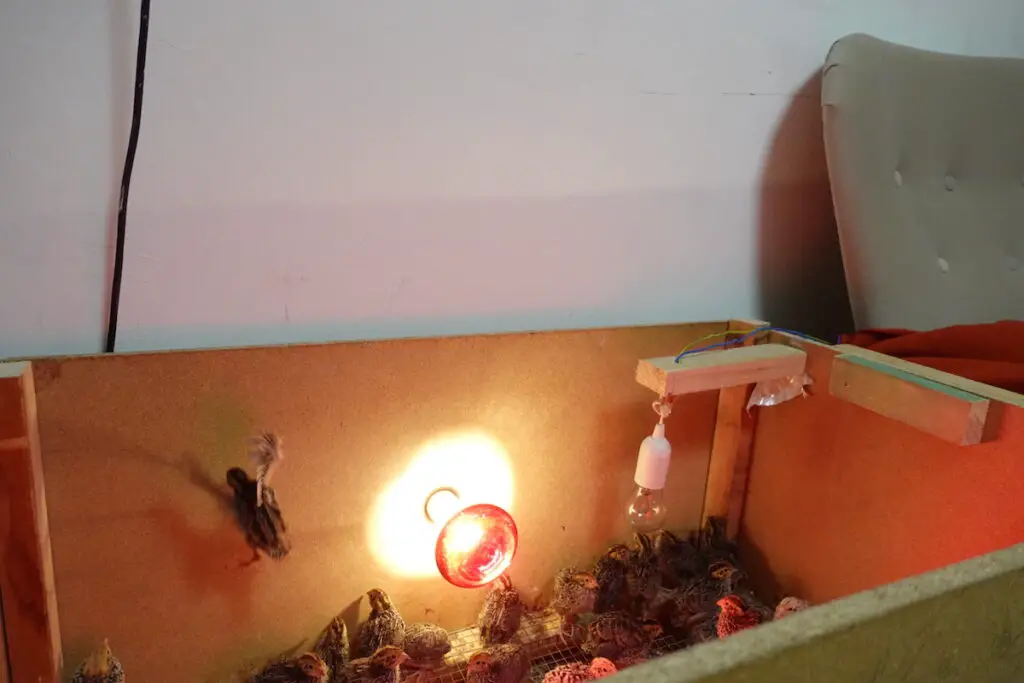Newly hatched quail can’t regulate their body temperature. Their feathers don’t provide sufficient protection against the cold. After your quail eggs have hatched and you’ve moved your baby quail into the brooder, the temperature in your brooder can greatly affect the survival rate of your quail chicks.
A poultry heater is the easiest way to keep your quail warm in the brooder in a home setup because it provides a constant heat source for the chicks. It works best when set up in a location with a constant temperature without any draft. A ceramic bulb or a heat lamp also works well in some setups.
We’re going to look at each method in detail, explaining the pros and cons of each so you can decide which is the best for you.
Poultry heater
Poultry heaters are the easiest way to regulate the temperature in your brooder. They stand on four adjustable legs and can be raised as your quail chick grow.
Learn how to raise your own quail and have an unlimited supply of eggs and meat.
I love that they provide an even temperature throughout the whole surface, and they don’t have any hot or cold spots. My quail love rubbing their backs against the heater, and when they are sufficiently warm, they come out to explore the colder areas of the brooder. It’s similar to how they keep warm under a quail hen.
These heaters consume the least amount of energy of all the options, which is one of the reasons I like it (20-40 Wh instead of 100-250 Wh).
Many poultry heaters have an optional temperature dial that allows you to adjust their heat. Even though I don’t use this optional accessory on mine, it’s a good option to have.

Since they don’t emit any light, they also allow your birds to get used to a day-night rhythm. Once you turn off the light in the room for the night, all your baby quail go to sleep.
You can purchase these heaters in different sizes depending on how many quail you have and how big your brooder box is.
Poultry heaters have three main drawbacks.
One is that they warm the chicks but not the air inside the brooder (this is why they are so energy efficient). When the quail come out to explore, they soon need to return under the heater to warm up again. If the room temperature is very cold, this could lead to your quail chicks getting cold.
The other downside is that you can’t place the feeder and the waterer under the heater, and your quail are bound to come out to eat and drink.
Both of these cons are also pros because they train the chicks to get used to temperature swings as they grow.
The third con is that they come in set sizes, which means you’re limited in how many quail you can fit underneath and how big brooder boxes you can use them with. They are less flexible than the other options.
All-in-all, this is my favorite option, and I consider this as an upgrade from the heat lamp that I used initially.

Let’s recap.
Poultry heater pros
- Even temperature distribution
- Imitates quail hen’s temperature regulation
- No fire hazard
- Low consumption
- Allow for a natural day-night rhythm
- Can be raised as the chicks grow
Poultry heater cons
- Doesn’t heat the air in the brooder but only the chicks
- Feeder and waterer don’t fit under it
- Less flexible than other options
Ceramic heat bulb
Ceramic heat bulbs are commonly used in reptile terrariums. They are also quite popular among poultry keepers because they don’t emit any visible light, and they don’t get as hot as heat lamps do.
Ceramic bulbs are used just like normal light bulbs and screw into the same socket. In fact, you can replace one type with the other one in just a few seconds.
These are usually between 75 and 250W, but they don’t get as hot as regular bulbs. This makes them a safer option from a fire hazard standpoint.
They are used in conjunction with heat lamp shields and are hung above the brooder box in such a way that they radiate warmth down. Depending on their capacity, how high they are located above the box, and the brooder size, they can keep the entire brooder warm. If your brooder is set up in a cooler location, this is better than a poultry heater because your chicks can stay warm even while they are eating and drinking.
Also, since there is no visible light, they are also good to get the chicks used to the day-night cycle.
The main downside of ceramic bulbs is that they are less efficient than heat lamps. You need to get a bigger capacity bulb to keep the brooder warm.
Another thing to consider is that if you have a large brooder, you may need to place several bulbs in it in a strategic way to avoid cold and hot spots.
Ceramic bulb pros
- Simple setup
- Can keep the entire brooder warm
- Doesn’t affect day-night cycle
Ceramic bulb cons
- Less efficient than poultry heaters or heat lamps
- May create uneven temperature in the brooder with some hot and cold spots.
Heat lamp
Traditional heat lamps also work well with quail, and many breeders use them. I also started with this type of setup in my brooder, and it worked well.
Heat lamps can be clamped over the brooder box with a heat shield that directs the warmth down. Since they get very hot to the touch, they require the most precaution among all the options as poorly attached lights pose a real fire hazard. Reports of brooders catching fire due to the bulb falling off are not uncommon.
When I used an infrared bulb in my brooder, I installed a socket on one of its walls (as shown in the picture below). I covered the top of the brooder with a board and some tin foil, which radiated the warmth back down to the chicks.

If you install the light inside the brooder, ensure it is high enough so the quail don’t touch it, and nothing is too close to catch fire.
I graduated from this setup when one of my quail jumped up in fright and broke the bulb with its head.
Also, heat lamps have a shorter lifespan than the other two options.
Heat lamps can create hot spots in the brooder, making the temperature difficult to regulate, especially if installed in a fixed position inside the brooder.
Since heat lamps emit light and heat together, they manipulate the day-night cycle of the quail chicks. They experience every moment of the day constantly bright.
Heat lamp pros
- Can be found in all pet shops
- Provide a lot of heat
Heat lamp cons
- Fire hazard
- Affects day-night rhythm
- Short lifespan
- Hard to regulate temperature
Another (not good) option
Some breeders use reptile heat pads to keep the quail chicks warm in the brooder. The concept is similar to the poultry heater, but the main difference is that the heat comes from below and radiates up.
The main reason reptile heat pads are not recommended is that the quail produce a lot of waste that contains ammonia. With heat radiating up, this leads to faster evaporation, and ammonia-rich air can cause respiratory problems to your quail.
Which is best for you
You can keep your brooder warm with a heat lamp if you like a traditional approach. Opt for a ceramic lamp if you prefer something safer but something that gives you some flexibility.
If you are like me and want to give your chicks the option to warm up as needed in a way that best imitates nature, look into a poultry heater.
If you need a full guide on how to set up your brooder and how to raise your quail chicks in the first few weeks of their lives, read this article I wrote specifically for you.
Happy quailing!

